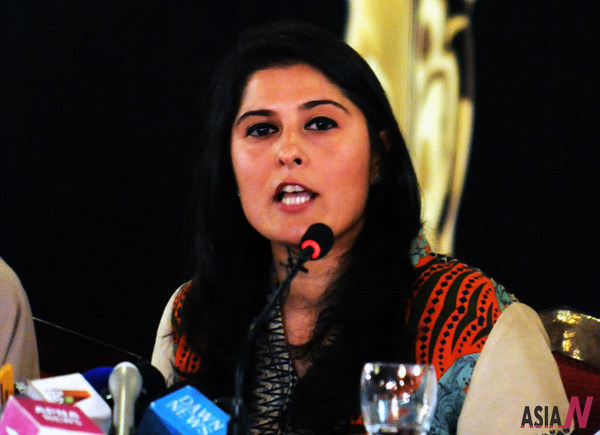Acid, a cheap weapon to deface lives in Pakistan

- Oscar winner Pakistani film maker Sharmeen Obaid-Chinoy addresses a press conference in southern Pakistani port city of Karachi on March 10, 2012. Sharmeen Obaid-Chinoy won Pakistan’s first ever Oscar in the short documentary category with her film “Saving Face” about survivors of acid attacks and British Pakistani plastic surgeon Mohammad Jawad, who returned to his homeland to help restore their faces and lives. <Photo: Xinhua>
Before the year 2003, Naila Farhat had never imagined that her rosy plump cheeks, pink lips, broad smile and charming days would be converted into a half-blind maladroit look and a life full of agony and sorrows as a defaced survivor of acid attack.
The use of acid as weapon to deface people’s lives has alarmingly risen across Pakistan during last couple of years despite the government enacted a law last year against acid attackers with 14 years to life imprisonment and one million rupees fine.
Farhat, 21, still remembers her good days when she was only 13 and a student of eighth class, before a rejected suitor and his friend, Farhat’s school teacher, poured a whole bottle of acid at her face in the district Layyah of Punjab province.
“They forced me to go along with them, and because of my refusal they splashed acid at my face. Suddenly, my face started burning and got swollen and every thing was looking blue to me,” Farhat told Xinhua.
According to Human Rights Commission of Pakistan, about two hundred acid attack incidents are reported every year, which are 30 percent of the actual attacks take place in the country.
Though the case was registered against Farhat’s both culprits, police did not charge the teacher after allegedly taking bribes but the court sentenced the suitor with 12 years imprisonment and 1.2 million rupees (13,333 U.S. dollars) fine.
Farhat was satisfied over what she had achieved through court though she has not received the fine amount yet.
Maryam Yasmin, a lawyer cum social worker, said reasons behind this criminal act include personal feud, family issue, proposal rejection, disapproval or disagreement, land or financial dispute and jealousy.
Another victim Mumtaz Mai who was attacked along with her children said, “We had a land dispute with our relatives who later, at one night, jumped into our house and threw acid at my two sons, my mother-in-law and me.”
Mai’s both sons had to leave their studies because doctors advised them for proper treatment.
Around half of the acid victims are female, and 26 percent are male while the rest of them are the children. Out of the total female victims, at least 70 percent are under the age of 18.
Most of the cases are reported from the southern part of the Punjab province where poverty and illiteracy rates are many times higher than other parts of the country and acid is widely used for agricultural purposes.
“The acid price is extremely cheap in South Punjab and is available at every corner,” Yasmin said, adding “enforcement agencies should stop this practice and bring responsible persons into the court.”
The biggest concern for acid victims is proper treatment as the expanses are huge and there is only one state of the art hospital – the Pakistan Institute of Medical Sciences (PIMS) for acid burns in capital Islamabad.
Plastic and burns surgeon Dr. Tariq Iqbal, head of the Burn Care Center at PIMS, said the treatment cost of an acid burn victim in initial phases may go around 45 U.S. dollars to 135 U.S. dollars per day and it might take months to recover.
“The cost is enormous but the good thing is that the government of Pakistan is providing all the cost to these patients and the whole treatment is free of cost,” said Iqbal.
Though the treatment is free at PIMS but its capacity to admit patients is also limited.
Tariq along with some other people had established the ” Pakistan Burns Association,” an organization with the aim to rehabilitate the burn victims.
Pakistani origin Danish national Dr. Mazhar Hussain, who often visits Pakistan to provide free hair transplantation for acid victims, told Xinhua that most of the victims are the poor who often don’t have the funds and information about people or doctors that can help them.
“From a treatment point of view they (victims) are in a very bad position. People with good education and wealth can fight it easier but most of the victims are in a very tough place,” Hussain added.
Such patients have to fight against all odds – against family, friends and society that pressurize them to stop from suing the culprits. Some of the girls who faced this tragedy reportedly committed suicide after they saw their ruined face, or changed social behaviors.
The Supreme Court’s decision in Farhat’s case set an example, encouraging other victims to knock the court’s door and resort to law.
In November last year, Pakistan’s lower house passed the Criminal Law (Amendment) Act, 2011, which suggests punishment for the offenders.
“Whoever causes hurt by corrosive substance shall be punished with imprisonment for life or imprisonment of either description which shall not be less than fourteen years and a minimum fine of one million rupees,” the new Act reads.
But social workers believe that a lot of work is yet to be done to address the challenges of investigation, fair trial, free medical and rehabilitation services and financial assistance. <Xinhua/Jamil Bhatti, Zeeshan Niazi>





















































